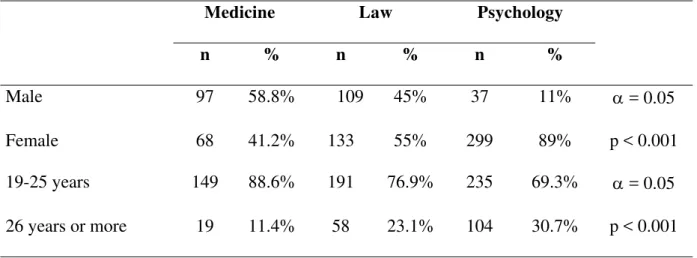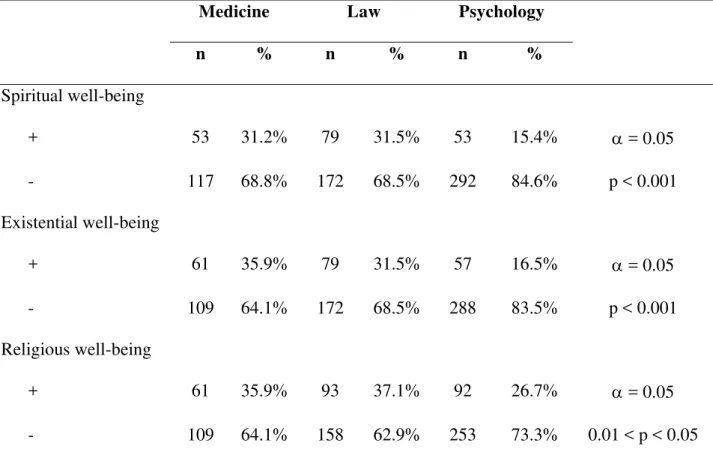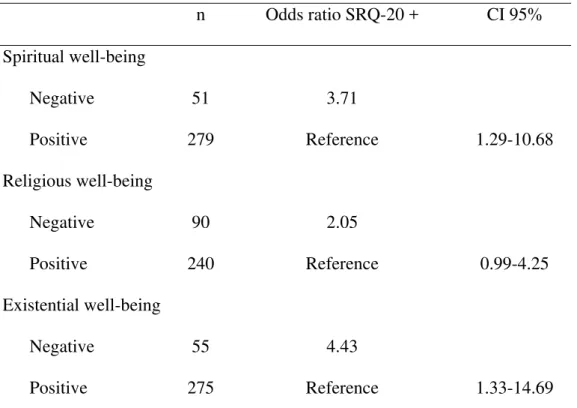Original article
Spiritual well-being and minor psychiatric disorders in psychology students: a cross-sectional study
Marina Bento Gastaud* Luciano Dias de Mattos Souza**
Laryssa Braga* Cristina Lessa Horta*** Flávio Martinez de Oliveira***
Paulo Luis Rosa Sousa**** Ricardo Azevedo da Silva****
* University students, Psychology, Universidade Católica de Pelotas, Pelotas, RS, Brazil. ** MSc. in Health and Behavior, Universidade Católica de Pelotas, Pelotas, RS, Brazil. *** Professors, Universidade Católica de Pelotas, Pelotas, RS, Brazil.
**** Professor, Psychology, and Advisor, MSc. in Health and Behavior, Universidade Católica de Pelotas, Pelotas, RS, Brazil.
INTRODUCTION
Religiousness and spirituality have always been considered important allies of people who are suffering and/or sick. However, Western medicine as a whole and especially psychiatry have shown two basic attitudes towards the theme: 1) negligence, by considering such issues irrelevant or not within the scope of their main interest area; 2) opposition, by characterizing their patients’ religious experiences as evidences of different psychopathologies.1,2
According to the World Health Organization, 24% of the people who go to primary care centers present psychiatric disorders, such as depression, anxiety and inadequate use of substances.3 Among the urban population of Pelotas (Brazil), a prevalence of 22.7% of minor psychiatric disorders (MPD) was found in people over 15 years.4 Therefore, there is a need to develop new forms of promoting mental health in the population, forms that should also consider the “spiritual” dimension, which is an increasing tendency.5
The spirituality issue is very wide, and its measurement is quite complex; the spiritual well-being (SWB) is one of its aspects that may be evaluated. SWB is understood as the individual’s subjective perception of well-being in relation to his/her belief. The development of measurement instruments of SWB was based on the concept of spirituality that involves a vertical, religious component (a sense of well-being in relation to God), and a horizontal, existential component (a sense of life purpose and satisfaction); the latter does not imply any reference to a specifically religious content.6 The spirituality is about issues concerning the meaning of life and the reason for living, it is not limited to some types of beliefs or practices. Religion is defined as the belief in the existence of a supernatural power, creator and controller of the universe, which gave men a spiritual nature that keeps existing after the death of the body. Religiousness is the extent to which an
individual believes, follows and practices a religion.
both a predictor and a disaggregating factor for mental health. A review study showed a positive association of 50% of cases and negative in 25% of them. In this review, religiousness was considered as being a protective factor for suicide, drug and alcohol abuse, reckless behavior, marital satisfaction, psychological suffering and some diagnoses of functional psychoses.9 Volcan et al. also showed that the SWB acts as an associated factor for MPD, once the chances of
individuals with low and moderate SWB presenting such disorders are doubled.
Despite the association between mental health and religiousness, there is a disparity between the beliefs of psychology and psychiatry professionals and the beliefs of the population in general. Whereas around 90% of the general population believe in God, only 43% of a sample of
psychiatrists members of the American Psychiatric Association have such belief.10
There is a lack of studies in the literature involving religiousness and psychology students. We found a recent study by Lewis, with 48 psychology students in Ireland. In this study, he found that religiousness is perceived as being followed by high levels of obsessiveness, suggesting the existence of a stereotype or preconceived notion with regard to the effects of religion on mental health among psychology students.11
The findings suggest that religiousness and mental health are positively associated,11 and that the strengthening of SWB may significantly help in the reduction of the anxiety related to diseases and in the promotion of health.6 Nevertheless, there is the hypothesis that professionals and students of mental health would have a low score in the SWB scale (SWBS).
METHODS
During 2002, all psychology students at Universidade Católica de Pelotas (Brazil) were interviewed (n = 351). Data were collected by a single psychology student. A self-reporting
questionnaire, containing the SRQ-20 and the SWBS, by Paloutzian & Ellison, was used, as well as sociodemographic information.
The SWBS is composed of 20 items; 10 of them assess the religious well-being (RWB) and the others assess the existential well-being (EWB). Each of the 20 items is answered in a 6-point scale, which varies from “strongly agree” to “strongly disagree”. The interviewee has to respond to statements such as “I believe that God is concerned with my problems” for RWB and “I feel
accomplished and satisfied with my life” for EWB. The scores of the two subscales are summed to obtain the general measure of SWB. Reliability tests, obtained from a sample of 100 volunteer students at the University of Idaho, had as results the coefficients of 0.93 (SWB), 0.96 (RWB) and 0.86 (EWB). As an index of internal consistency, the alpha coefficients found were 0.89 for the general index, 0.87 for the subscale of RWB and 0.78 for the subscale of EWB. The magnitude of these coefficients suggests that the SWBS has high reliability and internal consistency. The SWBS scores are correlated, as expected, to other evaluation measurements of spirituality/religiousness, as well as to other well-being indices. Paloutzian & Ellison suggest as cut-off points for the general SWB score the intervals of 20 to 40, 41 to 99 and 100 to 120, for low, moderate and high SWB, respectively. In both subscales, the intervals are 10 to 20, 21 to 49 and 50 to 60 points12. In our analysis, the SWBS results were called positive for high scores and negative for moderate and low scores.
We chose to use this instrument because it allows the quantitative measurement of
spirituality, making a difference between the strictly religious dimension; it was adapted to Brazil by Volcan et al..6
who obtained scores up to 7 points and female individuals with scores up to 6 points would be classified as negative SRQ-20, whereas those who obtained higher scores would be considered positive SRQ-20.
The data input was made using the Epi-Info 5.0, and the data analysis was made using the SPSS.
Initially, the data from the psychology students were organized into tables using relative and percentage frequencies. The chi-square test was used to evaluate the significance of the difference between these results and the relative results related to law and medical schools. The logistic regression was used to evaluate the association between MDP and SWB. The odds ratio was calculated considering two possibilities of response with regard to SWB (negative and positive) in relation to the SRQ-20 result.
The project was approved by the research ethics committee of Santa Casa de Pelotas.
RESULTS
The data obtained from the psychology students were compared to the results found by Volcan et al.6 in an earlier survey using the same methodology to compare and describe a sample of law and medical students at the same university. The sum of the samples included the total of 815 students in the analysis.
The study previously performed surveyed 464 university students, enrolled in the third, fourth and fifth years of law and medical school, between May and June 2001. Data were collected by psychologists or psychology students, and the absent students were asked to individually fill in the questionnaire; of these, 43 were not found (9.3% of the sample).6
Table 1 - Distribution of the sample with regard to gender and age group
Medicine Law Psychology n % n % n %
Male 97 58.8% 109 45% 37 11% α = 0.05
Female 68 41.2% 133 55% 299 89% p < 0.001
19-25 years 149 88.6% 191 76.9% 235 69.3% α = 0.05
26 years or more 19 11.4% 58 23.1% 104 30.7% p < 0.001
Mean age of the groups was 24.4 years; the age of medical students ranged from 20 to 33 years; law students was between 19 and 59 years; and psychology students from 17 to 64 years. Whereas 30.7% of psychology students were 26 years or more, only 11.4% of the sample of medical students was in this age group (p < 0.001)
Table 2 - Distribution of the sample with regard to SWBS and subscales
Medicine Law Psychology n % n % n % Spiritual well-being
+ 53 31.2% 79 31.5% 53 15.4% α = 0.05
- 117 68.8% 172 68.5% 292 84.6% p < 0.001
Existential well-being
+ 61 35.9% 79 31.5% 57 16.5% α = 0.05
- 109 64.1% 172 68.5% 288 83.5% p < 0.001
Religious well-being
+ 61 35.9% 93 37.1% 92 26.7% α = 0.05
- 109 64.1% 158 62.9% 253 73.3% 0.01 < p < 0.05 Positive was considered for high scores and negative for moderate and low scores.
In the RWB variable, there was more similarity between the groups. Positive results were obtained by 35.9% of medical students, 37.1% of law students and 26.7% of psychology students (p < 0.05).
Table 3 - Distribution of the sample with regard to SRQ-20 performance
Medicine Law Psychology n % n % n % SRQ-20
+ 34 20% 44 17.5% 71 21.1% α = 0.05
- 136 80% 207 82.5% 265 78.9% p > 0.50
Negative was considered for scores up to 7 points for females and up to 6 points for males. Among the psychology students, there was a loss of n = 15 in this evaluation.
Table 4 - Association between spiritual well-being and its subscales with mental health in psychology students
n Odds ratio SRQ-20 + CI 95% Spiritual well-being
Negative 51 3.71
Positive 279 Reference 1.29-10.68
Religious well-being
Negative 90 2.05
Positive 240 Reference 0.99-4.25
Existential well-being
Negative 55 4.43
Positive 275 Reference 1.33-14.69
The results point to an inverse relation between well-being levels and SRQ scores.
DISCUSSION
The results of the present study indicate that the psychology students with MPD present more chances of having low scores in the EWB scale. They also indicate that the psychology students with such disorders had doubled chances to obtain low scores in the RWB. However, in this case, we cannot say that the relation is significant (since its lowest value is 0.99), although there is a strong tendency (since the interval comprehends 1).
These findings confirm the hypothesis that psychology students would obtain lower SWB, existential and religious scores than law and medical students.
Furthermore, it can be seen that there is still a great distance between religion and science among psychology students, once they seem to “exist in separate spheres or with little
intersection”.15 It has been speculated that Freud’s view on religion would be that it is to social life what neurosis is to the individual life,16 and it can also be considered a major factor for the
existence of this marked difference in scores between the courses.
On the other hand, recent studies suggest that religion performs two essential psychological and cultural tasks: it allows the construction of a possible world, with a plausible and acceptable order, providing meaning to the phenomenal chaos of experience, besides allowing man to give meaning to his suffering. Therefore, from a perspective of contemporary social and psychological sciences, religion is no longer seen as a simple defensive or alienating system. Its role as a social institution, organizing the subjective experience, has been emphasized both by social scientists and by researchers in the mental health area.17 Such idea would confirm the finding that, in this sample, the presence of MPD is associated with low RWB scores.
The sample of the three courses presented a lower prevalence of MPD than population-based studies previously published.4 Among the possible reasons for this difference are: 1) the concentration of subjects with better socioeconomic resources attending a private university, 2) the possible previous knowledge of the scale by medical and psychology students and 3) the knowledge of psychopathology by health students, as a higher awareness of one’s own problems would lead him/her to seek treatment resources. Nonetheless, there were no significant differences with regard to the prevalence of MPD between the courses, indicating a sample homogeneity. Such finding confirms the argument that the socioeconomic factor would be the strongest one in this issue.
Although religiousness and spirituality are distinct from one another because the former clearly suggests a system of worship and specific doctrine that is shared by a group, there is a considerable superposition of these notions, as high RWB levels tend to increase EWB scores, by providing life and existence with a meaning.
Therefore, even that they contribute to understand the issue, the results obtained do not allow the establishment of causal relations, due to limitations of the cross-sectional study design.
CONCLUSIONS
The findings suggest that the SWB is a factor inversely related to MPD. Students with high SRQ-20 scores presented more chances of having lower scores in the SWBS.
REFERENCES
1. Pargament KI, Brant CR. Religion and coping. In: Koenig HG, ed. Handbook of religion and mental health. London: Academic Press; 1998. p. 111-28.
2. Sims A. Psyche - Spirit as well as mind? Br J Psychiatry. 1994;165(4):441-6.
3. World Health Organization. Division of mental health and prevention of substance abuse. WHOQOL and spirituality, religiousness and personal beliefs (SRPB) - report on WHO Consultation. Geneve: WHO; 1998.
4. Lima M, Soares BGO, Mari JJ. Saúde e doença mental em Pelotas, RS: dados de um estudo populacional. Rev Psiquiatr Clin. 1999;26(5):225-35.
5. American Psychiatric Association. Diretrizes para o tratamento de transtornos psiquiátricos. Porto Alegre: Artmed; 2004.
6. Volcan SM, Sousa PL, Mari JJ, Horta B. Relação entre bem-estar espiritual e transtornos psiquiátricos menores: estudo transversal. Rev Saude Publica. 2003;37(4):440-5.
7. Lotufo Neto F. Psiquiatria e religião: a prevalência de transtornos mentais entre ministros religiosos [tese de livre-docência]. São Paulo: Universidade Federal de São Paulo; 1997. 8. Sousa PLR, Tillmann IA, Horta CL, Oliveira FM. A religiosidade e suas interfaces com a
medicina, a psicologia e a educação: o estado de arte. Psiq Prat Med. 2001;34(4):112-7. 9. Levin, JS, Chatters LM. Research on religion and mental health: an overview of empirical
findings and theoretical issues. In: Koenig HG, ed. Handbook of religion and mental health. London: Academic Press; 1998. p.33-50.
10. Larson DB, Pattison EM, Blazer DG, Omram AR, Kaplan BH. Systematic analysis of research on religion variables in four major psychiatric journals, 1978-1982. Am J Psychiatry. 1986;143(3):329-34.
12. Paloutzian R, Ellison C. Loneliness, spiritual well-being and the quality of life. In: Peplau D, Perlman D. Loneliness: a sourcebook of current theory, research and therapy. New York: John Wiley and Sons; 1982. p. 224-35.
13. Mari JJ, Williams P. A validity study of a psychiatric screening questionnaire (SRQ-20) in primary care in the city of São Paulo. Br J Psychiatry. 1986;148:23-6.
14. Grabovac AD, Ganesan S. Spirituality and religion in Canadian psychiatry residency training. Can J Psychiatry. 2003;48(3):171-5.
15. Paiva GJ. Representação social da religião em docentes-pesquisadores universitários. Psicol USP. 1999;10(2):227-39.
16. Freud S. Totem e tabu. Rio de Janeiro: Imago; 1974. v. 13.
17. Dantas CR, Pavarin LB, Dalgalarrondo P. Sintomas de conteúdo religioso em pacientes psiquiátricos. Rev Bras Psiquiatr. 1999;21(3):158-64.
18. Fallot RD. The place of spirituality and religion in mental health services. New Dir Ment Health Serv. 2001;Fall(91):79-88.
ABSTRACT
Introduction:Religiosity/spirituality and mental health seem to be positively associated. This study examines associations between spiritual well-being and psychiatric disorders in psychology
students.
Methods:A spiritual well-being scale – the self-reporting questionnaire (SRQ-20) – and sociodemographic information were used to all psychology students (n = 351) from Universidade
Católica de Pelotas, RS, Brazil, during the year of 2002. Current scores were compared to those
obtained from medical and law students of the same university in 2001 (n = 464).
association of 3.71 (95% CI 1.29-10.68) between spiritual well-being and the SRQ-20 scores of
psychology students.
Discussion:The findings coincide with the international experience. It is a matter of concern that psychology students define themselves more distant from spiritual/religious issues, considering
the association spirituality/health-illness.
Conclusion:Spirituality-religiosity appeared as a factor inversely associated to minor psychiatric disorders among psychology students.
Keywords: Spirituality, religiosity, psychology students, mental health, minor psychiatric disorders.
Title: Spiritual well-being and minor psychiatric disorders in psychology students: a cross-sectional study
Correspondence: Marina Gastaud



